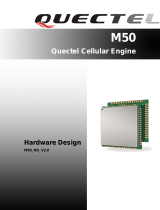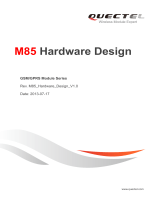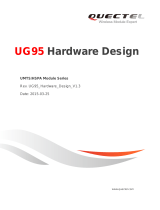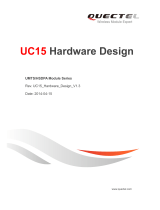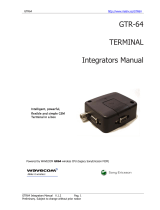Page is loading ...

M12
Quectel Cellular Engine
Hardware Design
M12_Hardware_Design_V3.3

M12 Hardware Design
M12_Hardware_Design_V3.3 - 1 -
Document Title
M12 Hardware Design
Revision
3.3
Date
2012-10-25
Status
Released
Document Control ID
M12_Hardware_Degsign_V3.3
General Notes
Quectel offers this information as a service to its customers, to support application and
engineering efforts that use the products designed by Quectel. The information provided is
based upon requirements specifically provided for customers of Quectel. Quectel has not
undertaken any independent search for additional information, relevant to any information
that may be in the customer’s possession. Furthermore, system validation of this product
designed by Quectel within a larger electronic system remains the responsibility of the
customer or the customer’s system integrator. All specifications supplied herein are subject to
change.
Copyright
This document contains proprietary technical information of Quectel Co., Ltd. Copying of
this document, distribution to others, and communication of the contents thereof, are
forbidden without permission. Offenders are liable to the payment of damages. All rights are
reserved in the event of a patent grant or registration of a utility model or design. All
specification supplied herein are subject to change without notice at any time.
Copyright © Quectel Wireless Solutions Co., Ltd. 2012
Quectel
Confidential

M12 Hardware Design
M12_Hardware_Design_V3.3 - 2 -
Contents
Table Index ........................................................................................................................................ 4
Figure Index ...................................................................................................................................... 5
0. Revision history ............................................................................................................................ 7
1. Introduction ................................................................................................................................... 8
1.1. Related documents .............................................................................................................. 8
1.2. Terms and abbreviations ...................................................................................................... 9
1.3. Safety cautions .................................................................................................................. 11
2. Product concept ........................................................................................................................... 13
2.1. Key features ...................................................................................................................... 13
2.2. Functional diagram ............................................................................................................ 15
2.3. Evaluation board ............................................................................................................... 16
3. Application interface ................................................................................................................... 17
3.1. Pins of module ................................................................................................................... 17
3.1.1. Pin assignment ......................................................................................................... 17
3.1.2. Pin description ......................................................................................................... 18
3.2. Operating modes ............................................................................................................... 23
3.3. Power supply ..................................................................................................................... 25
3.3.1. Power features of module ........................................................................................ 25
3.3.2. Decrease supply voltage drop .................................................................................. 25
3.3.3. Reference design for power supply ......................................................................... 26
3.3.4. Monitor power supply ............................................................................................. 27
3.4. Power up and power down scenarios ................................................................................ 27
3.4.1. Power on module using PWRKEY pin ................................................................... 27
3.4.2. Power down ............................................................................................................. 29
3.4.3. Restart module using PWRKEY pin ....................................................................... 32
3.5. Power saving ..................................................................................................................... 33
3.5.1. Minimum functionality mode .................................................................................. 34
3.5.2. SLEEP mode (slow clock mode) ............................................................................. 34
3.5.3. Wake up module from SLEEP mode ...................................................................... 34
c3.6. Summary of state transitions ........................................................................................... 35
3.7. RTC backup ...................................................................................................................... 35
3.8. Serial interfaces ................................................................................................................. 37
3.8.1. UART Port .............................................................................................................. 38
3.8.2. Debug Port ............................................................................................................... 41
3.8.3. UART3 Port ............................................................................................................ 42
3.8.4. UART Application .................................................................................................. 43
3.9. Audio interfaces................................................................................................................. 45
3.9.1. Decrease TDD noise and other noise ...................................................................... 46
3.9.2. Microphone interfaces configuration ....................................................................... 46
3.9.3. Receiver and speaker interface configuration .......................................................... 47
3.9.4. Earphone interface configuration ............................................................................ 49
Quectel
Confidential

M12 Hardware Design
M12_Hardware_Design_V3.3 - 3 -
3.10. SIM card interface ........................................................................................................... 50
3.10.1. SIM card application ............................................................................................. 50
3.10.2. SIM card holder ..................................................................................................... 52
3.11. ADC ................................................................................................................................. 54
3.12. Behaviors of the RI ......................................................................................................... 55
3.13. Network status indication ................................................................................................ 57
3.14. Operating status indication .............................................................................................. 58
3.15. General purpose input & output (GPIO) ......................................................................... 58
3.16. SD card interface ............................................................................................................. 59
4. Antenna interface ........................................................................................................................ 61
4.1. Antenna installation ........................................................................................................... 61
4.2. RF output power ................................................................................................................ 62
4.3. RF receiving sensitivity ..................................................................................................... 62
4.4. Operating frequencies ....................................................................................................... 62
4.5. Recommendation of RF pad welding ................................................................................ 62
5. Electrical, reliability and radio characteristics ............................................................................ 64
5.1. Absolute maximum ratings ................................................................................................ 64
5.2. Operating temperature ....................................................................................................... 64
5.3. Power supply ratings ......................................................................................................... 65
5.4. Current consumption ......................................................................................................... 66
5.5. Electro-static discharge ..................................................................................................... 67
6. Mechanical dimensions ............................................................................................................... 68
6.1. Mechanical dimensions of the module .............................................................................. 68
6.2. Footprint of recommendation ............................................................................................ 70
6.3. Top view of the module .................................................................................................... 72
6.4. Bottom view of the module ............................................................................................... 72
Appendix A: GPRS coding schemes ............................................................................................... 73
Appendix B: GPRS multi-slot classes............................................................................................. 74
Quectel
Confidential

M12 Hardware Design
M12_Hardware_Design_V3.3 - 4 -
Table Index
TABLE 1: RELATED DOCUMENTS ............................................................................................. 8
TABLE 2: TERMS AND ABBREVIATIONS .................................................................................. 9
TABLE 3: MODULE KEY FEATURES ........................................................................................ 13
TABLE 4: CODING SCHEMES AND MAXIMUM NET DATA RATES OVER AIR
INTERFACE .................................................................................................................. 15
TABLE 5: PIN DESCRIPTION ...................................................................................................... 18
TABLE 6: OVERVIEW OF OPERATING MODES ...................................................................... 24
TABLE 7: SUMMARY OF STATE TRANSITION ....................................................................... 35
TABLE 8: LOGIC LEVELS OF THE SERIAL INTERFACE ....................................................... 38
TABLE 9: PIN DEFINITION OF THE SERIAL INTERFACES ................................................... 38
TABLE 10: PIN DEFINITION OF AUDIO INTERFACE ............................................................. 45
TABLE 11: TYPICAL ELECTRET MICROPHONE CHARACTERISTIC ................................. 49
TABLE 12: TYPICAL SPEAKER CHARACTERISTIC ............................................................... 50
TABLE 13: PIN DEFINITION OF THE SIM INTERFACE .......................................................... 50
TABLE 14: PIN DESCRIPTION OF AMPHENOL SIM CARD HOLDER .................................. 53
TABLE 15: PIN DESCRIPTION OF MOLEX SIM CARD HOLDER ......................................... 54
TABLE 16: PIN DEFINITION OF THE ADC ............................................................................... 55
TABLE 17: CHARACTERISTICS OF THE ADC ......................................................................... 55
TABLE 18: BEHAVIORS OF THE RI ........................................................................................... 55
TABLE 19: WORKING STATE OF THE NETLIGHT .................................................................. 57
TABLE 20: PIN DEFINITION OF THE STATUS ......................................................................... 58
TABLE 21: PIN DEFINITION OF THE GPIO INTERFACE ....................................................... 58
TABLE 22: PIN DEFINITION OF THE SD CARD INTERFACE ............................................... 59
TABLE 23: PIN NAME OF THE SD CARD AND T-FLASH(MICRO SD) CARD ..................... 60
TABLE 24: PIN DEFINITION OF THE RF_ANT ........................................................................ 61
TABLE 25: THE MODULE CONDUCTED RF OUTPUT POWER ............................................ 62
TABLE 26: THE MODULE CONDUCTED RF RECEIVING SENSITIVITY ............................ 62
TABLE 27: THE MODULE OPERATING FREQUENCIES ........................................................ 62
TABLE 28: ABSOLUTE MAXIMUM RATINGS ......................................................................... 64
TABLE 29: OPERATING TEMPERATURE ................................................................................. 64
TABLE 30: THE MODULE POWER SUPPLY RATINGS ........................................................... 65
TABLE 31: THE MODULE CURRENT CONSUMPTION .......................................................... 66
TABLE 32: THE ESD ENDURANCE (TEMPERATURE:25℃,HUMIDITY:45 %) .................... 67
TABLE 33: DESCRIPTION OF DIFFERENT CODING SCHEMES ........................................... 73
TABLE 34: GPRS MULTI-SLOT CLASSES ................................................................................ 74
Quectel
Confidential

M12 Hardware Design
M12_Hardware_Design_V3.3 - 5 -
Figure Index
FIGURE 1: MODULE FUNCTIONAL DIAGRAM ...................................................................... 16
FIGURE 2: TOP VIEW OF MODULE PIN ASSIGNMENT ......................................................... 18
FIGURE 3: VOLTAGE RIPPLE DURING TRANSMITTING ..................................................... 25
FIGURE 4: REFERENCE CIRCUIT FOR THE VBAT INPUT .................................................... 26
FIGURE 5: REFERENCE CIRCUIT FOR POWER SUPPLY ...................................................... 26
FIGURE 6: TURN ON THE MODULE USING DRIVING CIRCUIT ......................................... 28
FIGURE 7: TURN ON THE MODULE USING KEYSTROKE ................................................... 28
FIGURE 8: TIMING OF TURNING ON SYSTEM ...................................................................... 29
FIGURE 9: TIMING OF TURNING OFF THE MODULE ........................................................... 30
FIGURE 10: REFERENCE CIRCUIT FOR EMERG_OFF BY USING DRIVING CIRCUIT .... 32
FIGURE 11: REFERENCE CIRCUIT FOR EMERG_OFF BY USING BUTTON ...................... 32
FIGURE 12: TIMING OF RESTARTING SYSTEM ..................................................................... 33
FIGURE 13: TIMING OF RESTARTING SYSTEM AFTER EMERGENCY SHUTDOWN ...... 33
FIGURE 14: RTC SUPPLY FROM NON-CHARGEABLE BATTERY ........................................ 35
FIGURE 15: RTC SUPPLY FROM RECHARGEABLE BATTERY ............................................ 36
FIGURE 16: RTC SUPPLY FROM CAPACITOR ......................................................................... 36
FIGURE 17: SEIKO XH414H-IV01E CHARGE CHARACTERISTIC ....................................... 37
FIGURE 18: CONNECTION OF ALL FUNCTIONAL UART PORT .......................................... 40
FIGURE 19: CONNECTION OF THREE LINES UART PORT ................................................... 40
FIGURE 20: CONNECTION OF UART PORT WITH HARDWARE FLOW CONTROL .......... 41
FIGURE 21: CONNECTION OF FIRMWARE UPGRADE ......................................................... 41
FIGURE 22: CONNECTION OF DEBUG PORT ......................................................................... 42
FIGURE 23: CONNECTION OF UART3 PORT ........................................................................... 43
FIGURE 24: 3.3V LEVEL MATCH CIRCUIT .............................................................................. 43
FIGURE 25: 5V LEVEL MATCH CIRCUIT ................................................................................. 44
FIGURE 26: RS232 LEVEL MATCH CIRCUIT ........................................................................... 45
FIGURE 27: MICROPHONE REFERENCE DESIGN FOR AIN1&AIN2 ................................... 47
FIGURE 28: REFERENCE DESIGN FOR AOUT1 ...................................................................... 47
FIGURE 29: REFERENCE DESIGN WITH AN AMPLIFIER FOR AOUT1 ............................... 48
FIGURE 30: REFERENCE DESIGN FOR AOUT2 ...................................................................... 48
FIGURE 31: REFERENCE DESIGN WITH AN AMPLIFIER FOR AOUT2 ............................... 49
FIGURE 32: REFERENCE DESIGN FOR AN EARPHONE ....................................................... 49
FIGURE 33: REFERENCE CIRCUIT OF THE 8 PINS SIM CARD ............................................ 51
FIGURE 34: REFERENCE CIRCUIT OF THE 6 PINS SIM CARD ............................................ 52
FIGURE 35: AMPHENOL C707 10M006 512 2 SIM CARD HOLDER ...................................... 53
FIGURE 36: MOLEX 91288 SIM CARD HOLDER ..................................................................... 54
FIGURE 37: RI BEHAVIOUR OF VOICE CALLING AS A RECEIVER .................................... 56
FIGURE 38: RI BEHAVIOUR OF DATA CALLING AS A RECEIVER ...................................... 56
FIGURE 39: RI BEHAVIOUR AS A CALLER ............................................................................. 56
FIGURE 40: RI BEHAVIOUR OF URC OR SMS RECEIVED .................................................... 57
FIGURE 41: REFERENCE CIRCUIT OF THE NETLIGHT ........................................................ 57
Quectel
Confidential

M12 Hardware Design
M12_Hardware_Design_V3.3 - 6 -
FIGURE 42: REFERENCE CIRCUIT OF THE STATUS ............................................................. 58
FIGURE 43: REFERENCE CIRCUIT OF SD CARD ................................................................... 59
FIGURE 44: REFERENCE CIRCUIT OF RF INTERFACE ......................................................... 61
FIGURE 45: RECOMMENDATION OF RF PAD WELDING ..................................................... 63
FIGURE 46: M12 TOP AND SIDE DIMENSIONS(UNIT: MM) ............................................ 68
FIGURE 47: M12 BOTTOM DIMENSIONS(UNIT: MM) ...................................................... 69
FIGURE 48: PAD BOTTOM DIMENSIONS(UNIT: MM) ...................................................... 69
FIGURE 49: FOOTPRINT OF RECOMMENDATION(UNIT: MM) ...................................... 71
FIGURE 50: TOP VIEW OF THE MODULE ................................................................................ 72
FIGURE 51: BOTTOM VIEW OF THE MODULE ...................................................................... 72
FIGURE 52: RADIO BLOCK STRUCTURE OF CS-1, CS-2 AND CS-3 .................................... 73
FIGURE 53: RADIO BLOCK STRUCTURE OF CS-4 ................................................................ 73
Quectel
Confidential

M12 Hardware Design
M12_Hardware_Design_V3.3 - 7 -
0. Revision history
Revision
Date
Author
Description of change
1.0
2010-07-20
Yong AN
Initial
1.1
2010-11-30
Yong AN
Added Chapter 4.5 for RF pad welding.
3.0
2012-02-14
Layne YE
1. Modified the power supply range.
2. Modified buzzer interface as RESERVED.
3. Modified the display interface as SD interface.
4. Modified the peak current in a transmitting burst.
5. Modified the current consumption in GSM talk
mode and GPRS communication mode.
6. Modified the RF receiving sensitivity.
3.1
2012-03-15
Layne YE
1. Deleted the content of charging function.
2. Modified the current consumption in GSM talk
mode and GPRS communication mode.
3. Disabled the module hardware flow control
status by default.
3.2
2012-04-16
Layne YE
1. Deleted the alarm function and relevant AT
Commands.
2. Deleted the function content of keyboard pins.
3. Deleted the function content of Light_MOS pin.
4. Deleted the FAX function.
5. Deleted the echo cancellation function.
6. Modified the keyboard pins as RESERVED.
7. Modified the name of GPIO1_KBC5 pin to
GPIO1.
3.3
2012-09-20
Layne YE
1. Updated the module functional diagram.
2. Modified the DC characteristics of VRTC.
3. Updated the voltage drop during burst emission.
4. Updated the SIM card reference circuit.
5. Modified the level match reference circuits for 5V
peripheral system.
6. Modified the maximum trace length of SD card
signals and the maximum trace difference.
7. The AOUT1 audio channel suppored voice and
audio output and so on.
Quectel
Confidential

M12 Hardware Design
M12_Hardware_Design_V3.3 - 8 -
1. Introduction
This document defines the M12 module and describes its hardware interface which are connected
with the customer application and the air interface.
This document can help customer quickly understand module interface specifications, electrical
and mechanical details. Associated with application notes and user guide, customer can use M12
module to design and set up mobile applications easily.
1.1. Related documents
Table 1: Related documents
SN
Document name
Remark
[1]
M12_ATC
M12 AT commands set
[2]
ITU-T Draft new
recommendation V.25ter
Serial asynchronous automatic dialing and control
[3]
GSM 07.07
Digital cellular telecommunications (Phase 2+); AT
commands set for GSM Mobile Equipment (ME)
[4]
GSM 07.10
Support GSM 07.10 multiplexing protocol
[5]
GSM 07.05
Digital cellular telecommunications (Phase 2+); Use of
Data Terminal Equipment – Data Circuit terminating
Equipment (DTE – DCE) interface for Short Message
Service (SMS) and Cell Broadcast Service (CBS)
[6]
GSM 11.14
Digital cellular telecommunications (Phase 2+);
Specification of the SIM Application Toolkit for the
Subscriber Identity module – Mobile Equipment (SIM –
ME) interface
[7]
GSM 11.11
Digital cellular telecommunications (Phase 2+);
Specification of the Subscriber Identity module – Mobile
Equipment (SIM – ME) interface
[8]
GSM 03.38
Digital cellular telecommunications (Phase 2+);
Alphabets and language-specific information
[9]
GSM 11.10
Digital cellular telecommunications (Phase 2); Mobile
Station (MS) conformance specification; Part 1:
Conformance specification
[10]
GSM_UART_AN
UART port application notes
[11]
M12_Hardware
Design_AN01
M12 hardware design application notes
[12]
GSM_FW_Upgrade_AN01
GSM Firmware upgrade application notes
[13]
M10_EVB_UGD
M10 EVB user guide
Quectel
Confidential

M12 Hardware Design
M12_Hardware_Design_V3.3 - 9 -
1.2. Terms and abbreviations
Table 2: Terms and abbreviations
Abbreviation
Description
ADC
Analog-to-Digital Converter
AMR
Adaptive Multi-Rate
ARP
Antenna Reference Point
ASIC
Application Specific Integrated Circuit
BER
Bit Error Rate
BOM
Bill Of Material
BTS
Base Transceiver Station
CHAP
Challenge Handshake Authentication Protocol
CS
Coding Scheme
CSD
Circuit Switched Data
CTS
Clear To Send
DAC
Digital-to-Analog Converter
DRX
Discontinuous Reception
DSP
Digital Signal Processor
DCE
Data Communications Equipment (typically module)
DTE
Data Terminal Equipment (typically computer, external controller)
DTR
Data Terminal Ready
DTX
Discontinuous Transmission
EFR
Enhanced Full Rate
EGSM
Enhanced GSM
EMC
Electromagnetic Compatibility
ESD
Electrostatic Discharge
ETS
European Telecommunication Standard
FCC
Federal Communications Commission (U.S.)
FDMA
Frequency Division Multiple Access
FR
Full Rate
GMSK
Gaussian Minimum Shift Keying
GPRS
General Packet Radio Service
GSM
Global System for Mobile Communications
HR
Half Rate
I/O
Input/Output
IC
Integrated Circuit
IMEI
International Mobile Equipment Identity
Imax
Maximum Load Current
Inorm
Normal Current
Quectel
Confidential

M12 Hardware Design
M12_Hardware_Design_V3.3 - 10 -
Abbreviation
Description
kbps
Kilo Bits Per Second
LED
Light Emitting Diode
Li-Ion
Lithium-Ion
MO
Mobile Originated
MS
Mobile Station (GSM engine)
MT
Mobile Terminated
PAP
Password Authentication Protocol
PBCCH
Packet Switched Broadcast Control Channel
PCB
Printed Circuit Board
PDU
Protocol Data Unit
PPP
Point-to-Point Protocol
RF
Radio Frequency
RMS
Root Mean Square (value)
RTC
Real Time Clock
RX
Receive Direction
SIM
Subscriber Identification Module
SMS
Short Message Service
TDMA
Time Division Multiple Access
TE
Terminal Equipment
TX
Transmitting Direction
UART
Universal Asynchronous Receiver & Transmitter
URC
Unsolicited Result Code
USSD
Unstructured Supplementary Service Data
VSWR
Voltage Standing Wave Ratio
Vmax
Maximum Voltage Value
Vnorm
Normal Voltage Value
Vmin
Minimum Voltage Value
VIHmax
Maximum Input High Level Voltage Value
VIHmin
Minimum Input High Level Voltage Value
VILmax
Maximum Input Low Level Voltage Value
VILmin
Minimum Input Low Level Voltage Value
VImax
Absolute Maximum Input Voltage Value
VImin
Absolute Minimum Input Voltage Value
VOHmax
Maximum Output High Level Voltage Value
VOHmin
Minimum Output High Level Voltage Value
VOLmax
Maximum Output Low Level Voltage Value
VOLmin
Minimum Output Low Level Voltage Value
Phonebook abbreviations
FD
SIM Fix Dialing phonebook
LD
SIM Last Dialing phonebook (list of numbers most recently dialed)
MC
Mobile Equipment list of unanswered MT Calls (missed calls)
Quectel
Confidential

M12 Hardware Design
M12_Hardware_Design_V3.3 - 11 -
Abbreviation
Description
ON
SIM (or ME) Own Numbers (MSISDNs) list
RC
Mobile Equipment list of Received Calls
SM
SIM phonebook
1.3. Safety cautions
The following safety precautions must be observed during all phases of the operation, such as
usage, service or repair of any cellular terminal or mobile incorporating M12 module.
Manufacturers of the cellular terminal should send the following safety information to users and
operating personnel and to incorporate these guidelines into all manuals supplied with the product.
If not so, Quectel does not take on any liability for customer failure to comply with these
precautions.
When in a hospital or other health care facility, observe the restrictions about the
use of mobile. Switch the cellular terminal or mobile off. Medical equipment may
be sensitive to not operate normally for RF energy interference.
Switch off the cellular terminal or mobile before boarding an aircraft. Make sure
it switched off. The operation of wireless appliances in an aircraft is forbidden to
prevent interference with communication systems. Forget to think much of these
instructions may lead to the flight safety or offend against local legal action, or
both.
Do not operate the cellular terminal or mobile in the presence of flammable gas
or fume. Switch off the cellular terminal when you are near petrol station, fuel
depot, chemical plant or where blasting operations are in progress. Operation of
any electrical equipment in potentially explosive atmosphere can constitute a
safety hazard.
Your cellular terminal or mobile receives and transmits radio frequency energy
while switched on. RF interference can occur if it is used close to TV set, radio,
computer or other electric equipment.
Road safety comes first! Do not use a hand-held cellular terminal or mobile
while driving a vehicle, unless it is securely mounted in a holder for hands-free
operation. Before making a call with a hand-held terminal or mobile, park the
vehicle.
Quectel
Confidential

M12 Hardware Design
M12_Hardware_Design_V3.3 - 12 -
GSM cellular terminals or mobiles operate over radio frequency signal and
cellular network and cannot be guaranteed to connect in all conditions, for
example no mobile fee or an invalid SIM card. While you are in this condition
and need emergent help, Please Remember using emergency call. In order to
make or receive call, the cellular terminal or mobile must be switched on and in
a service area with adequate cellular signal strength.
Some networks do not allow for emergency call if certain network services or
phone features are in use (e.g. lock functions, fixed dialing etc.). You may have
to deactivate those features before you can make an emergency call.
Also, some networks require that a valid SIM card be properly inserted in
cellular terminal or mobile.
Quectel
Confidential

M12 Hardware Design
M12_Hardware_Design_V3.3 - 13 -
2. Product concept
M12 is a Dual-band GSM/GPRS engine that works at frequencies of GSM900MHz and
DCS1800MHz. M12 features GPRS multi-slot class 12 and supports the GPRS coding schemes
CS-1, CS-2, CS-3 and CS-4. For more details about GPRS multi-slot classes and coding schemes,
please refer to Appendix A and Appendix B.
With a tiny profile of 29mm×29mm×3.6 mm, the module can meet almost all the requirements for
M2M applications, including Tracking and Tracing, Intelligent Instrument, Wireless POS,
Security, Telematics, Remote Controlling, etc.
M12 is a SMD type module, which can be embedded in customer application through its 64-pin
pads. It provides all hardware interfaces between the module and customer’s host board.
Designed with power saving technique, the current consumption of M12 is as low as 1.3 mA in
SLEEP mode when DRX is 5.
M12 is integrated with Internet service protocols, which are TCP/UDP, FTP and HTTP. Extended
AT commands have been developed for customer to use these Internet service protocols easily.
The modules are fully RoHS compliant to EU regulation.
2.1. Key features
Table 3: Module key features
Feature
Implementation
Power supply
Single supply voltage: 3.3V ~4.6V
Typical supply voltage: 4V
Power saving
Typical power consumption in SLEEP mode:1.3mA@ DRX=5
1.2mA@ DRX=9
Frequency bands
Dual-band: GSM900, DCS1800
The module can search these frequency bands automatically
The frequency bands can be set by AT command.
Compliant to GSM Phase 2/2+
GSM class
Small MS
Transmitting power
Class 4 (2W) at GSM900
Class 1 (1W) at DCS1800
GPRS connectivity
GPRS multi-slot class 12 (default)
GPRS multi-slot class 1~12 (configurable)
GPRS mobile station class B
Temperature range
Normal operation: -35°C ~ +75°C
Quectel
Confidential

M12 Hardware Design
M12_Hardware_Design_V3.3 - 14 -
Restricted operation: -40°C ~ -35°C and +75°C ~ +80°C
1)
Storage temperature: -45°C ~ +85°C
DATA GPRS
CSD
GPRS data downlink transfer: max. 85.6 kbps
GPRS data uplink transfer: max. 85.6 kbps
Coding scheme: CS-1, CS-2, CS-3 and CS-4
Support the protocols PAP (Password Authentication Protocol)
usually used for PPP connections
Internet service protocols TCP/UDP/FTP/HTTP/MMS/SMTP
Support Packet Switched Broadcast Control Channel (PBCCH)
CSD transmission rates: 2.4, 4.8, 9.6, 14.4 kbps non-transparent
Support Unstructured Supplementary Services Data (USSD)
SMS
MT, MO, CB, Text and PDU mode
SMS storage: SIM card
SIM interface
Support SIM card: 1.8V, 3V
Antenna interface
Connected via 50 Ohm antenna pad
Audio features
Speech codec modes:
Half Rate (ETS 06.20)
Full Rate (ETS 06.10)
Enhanced Full Rate (ETS 06.50 / 06.60 / 06.80)
Adaptive Multi-Rate (AMR)
Echo Suppression
Noise Reduction
Serial interface
Serial Port:
Seven lines on serial port interface
Used for AT command, GPRS data and CSD data
Multiplexing function
Support autobauding from 4800 bps to 115200 bps
Debug Port:
Two lines on second serial port interface DBG_TXD and
DBG_RXD
Used for software debugging and log output
UART3:
Used for AT command
Phonebook management
Support phonebook types: SM, FD, LD, RC, ON, MC
SIM Application Toolkit
Support SAT class 3, GSM 11.14 Release 99
Real time clock
Implemented
Alarm function
Programmable via AT command
Physical characteristics
Size:
29±0.15×29±0.15×3.6±0.3mm
Weight: 6g
Firmware upgrade
Firmware upgrade over Serial Port
1) When the module works in the temperature range, the deviation from the GSM specification
Quectel
Confidential

M12 Hardware Design
M12_Hardware_Design_V3.3 - 15 -
might occur. For example, the frequency error or the phase error could increase.
Table 4: Coding schemes and maximum net data rates over air interface
Coding scheme
1 Timeslot
2 Timeslot
4 Timeslot
CS-1:
9.05kbps
18.1kbps
36.2kbps
CS-2:
13.4kbps
26.8kbps
53.6kbps
CS-3:
15.6kbps
31.2kbps
62.4kbps
CS-4:
21.4kbps
42.8kbps
85.6kbps
2.2. Functional diagram
The following figure shows a block diagram of M12 and illustrates the major functional parts.
Power management
Baseband
Serial Flash
The GSM radio frequency part
The Peripheral interface
—Power supply
—Turn on/off interface
—UART interface
—Audio interface
—SIM interface
—ADC
—SD card interface
—RF interface
Quectel
Confidential

M12 Hardware Design
M12_Hardware_Design_V3.3 - 16 -
PWRKEY
EMERG_OFF
SIM
Interface
SD
Interface
BB&RF
RF PAM
SAW
Filter
Serial
Flash
32KHz
26MHzRF Transceiver
Audio
RTC
GPIO
Serial
Interface
Memory
Interface
SIM
Interface
SD
Interface
ADC
RF_ANT
VBAT
VRTC
ADC
GPIO &
Status&
Netlight
UART
Audio
Reset
ESD
PMU
Figure 1: Module functional diagram
2.3. Evaluation board
In order to help customer on the application of M12, Quectel supplies an Evaluation Board (EVB)
that hosts the module directly with appropriate power supply, SIM card holder, RS-232 serial
interface, handset RJ11 port, earphone port, antenna and other peripherals to control or test the
module. For more details, please refer to the document [13].
Quectel
Confidential

M12 Hardware Design
M12_Hardware_Design_V3.3 - 17 -
3. Application interface
The module is equipped with a 64-pin 1.3mm pitch SMT pad that connects to the cellular
application platform. Sub-interfaces included in these pads are described in detail in the following
chapters:
Power supply (refer to Section 3.3)
Serial interfaces (refer to Section 3.8)
Audio interfaces (refer to Section 3.9)
SIM interface (refer to Section 3.10)
SD interface (refer to Section 3.16)
Electrical and mechanical characteristics of the SMT pad are specified in Chapter 5&Chapter6.
3.1. Pins of module
3.1.1. Pin assignment
The following figure shows pin name and assignment of M12.
Quectel
Confidential

M12 Hardware Design
M12_Hardware_Design_V3.3 - 18 -
Figure 2: Top view of Module pin assignment
3.1.2. Pin description
Table 5: Pin description
Power supply
PIN NAME
PIN
NO.
I/O
DESCRIPTION
DC
CHARACTERISTICS
COMMENT
VBAT
50,51
52
I
Module main
power supply.
VBAT=3.3V~4.6V
Vmax= 4.6V
Vmin=3.3V
Vnorm=4.0V
It must be able to
provide sufficient
current in a
transmitting burst
which typically
Quectel
Confidential

M12 Hardware Design
M12_Hardware_Design_V3.3 - 19 -
rises to 1.6A.
VRTC
16
I/O
Power supply for
RTC when VBAT
is not supplied.
Charging for
backup battery or
golden capacitor
when the VBAT is
supplied.
VImax=3.3V
VImin=1.5V
VInorm=2.8V
VOmax=2.85V
VOmin=2.6V
VOnorm=2.8V
Iout(max)= 1mA
Iin=2.6~5 uA
Recommended to
connect to a
backup battery or a
golden capacitor.
VDD_EXT
7
O
Supply 2.8V
voltage for
external circuit.
Vmax=2.9V
Vmin=2.7V
Vnorm=2.8V
Imax=20mA
1. If unused, keep
this pin open.
2. Recommended
to add a 2.2~4.7uF
bypass capacitor,
when using for
power supply.
GND
8,42,
44~49
Digital ground
Turn on /off
PIN NAME
PIN
NO.
I/O
DESCRIPTION
DC
CHARACTERISTICS
COMMENT
PWRKEY
18
I
Power on/off key.
PWRKEY should
be pulled down for
a moment to turn
on or off the
system.
VILmax=0.1×VBAT
VIHmin=0.6×VBAT
VImax=VBAT
Pulled up to VBAT
internally.
Emergency shutdown
PIN NAME
PIN
NO.
I/O
DESCRIPTION
DC
CHARACTERISTICS
COMMENT
EMERG_
OFF
17
I
Emergency off.
Pulled down for at
least 20ms, the
module will be
turned off in case
of emergency. Use
it only when
normal shutdown
through PWRKEY
or AT command
cannot perform
well.
VILmax=0.4V
VIHmin=2.2V
V
open
max=2.8V
Open
drain/collector
driver required in
cellular device
application.
If unused, keep
this pin open.
Quectel
Confidential
/


